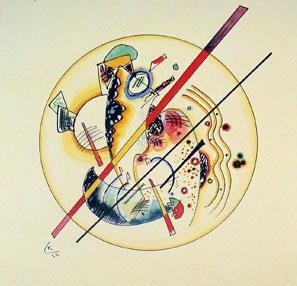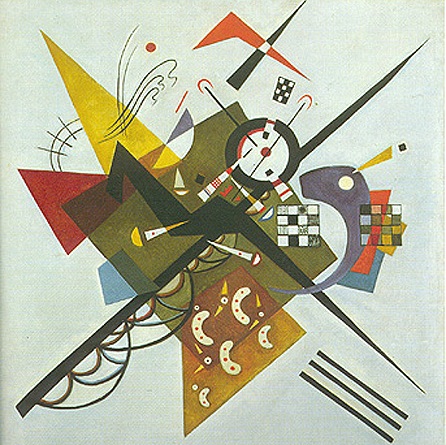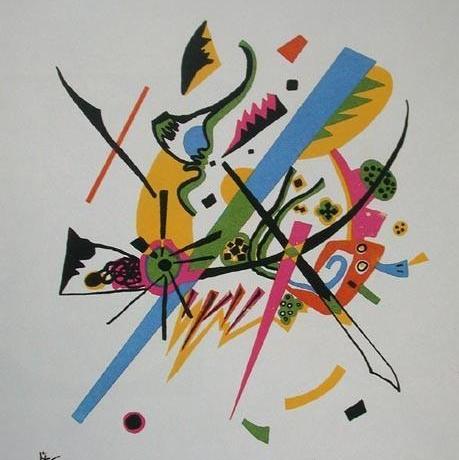Wassily Kandinsky - Anticipating the Future
Kandinsky anticipated the future by 72 years !
“Kandinsky described his reaction to the nuclear atom: ‘The collapse of the atom model was equivalent, in my soul, to the collapse of the whole world. Suddenly the thickest walls fell. I would not have been amazed if stone appeared before my eye in the air, melted, and became invisible.’
The radical nature of the scientific advances in the early twentieth century reverberated in modern culture. The fundamentals of art and literature and our understanding of psychology all changed radically at the tie. Although some attribute these developments to the upheaval and havoc of World War I, artists such as Wassily Kandinsky used the fact that the atom was penetrable to justify the idea that everything can change, and that in art, therefore, everything is allowed.
Finding heavy particles is not easy. Yet that’s what we must do if we are to discover the structure underlying …, ultimately, the physical makeup of the universe.” 1
The top quark was discovered by the CDF* and D0** experiments at Fermilab, and is by far the most massive of known elementary particles. “By 1994, several of CDF’s working groups had seen events that looked like the top quark (see Figure 2 below for an example), but they weren’t really sure. Although CDF couldn’t say with certainty that they found the top quark that year, both Do and CDF confirmed discovery in 1995.” As of 2007, Fermilab’s Tevatron is the only place in the world where top quarks can be produced.
* Collider Detector at Fermilab
** designation of the collision point between protons and antiprotons at which the detector was located.

Biographic Snapshot

1866 – 1944 Born in Moscow, Kandinsky spent his early childhood in Odessa. His parents played the piano and the zither and Kandinsky himself learned the piano and cello at an early age. The influence of music in his paintings cannot be overstated, down to the names of his paintings Improvisations, Impressions, and Compositions. In 1886, he enrolled at the University of Moscow, chose to study law and economics, and after passing his examinations, lectured at the Moscow Faculty of Law. He enjoyed success not only as a teacher but also wrote extensively on spirituality, a subject that remained of great interest and ultimately exerted substantial influence in his work.
In 1895 Kandinsky attended a French Impressionist exhibition where he saw Monet’s Haystacks at Giverny. He stated, “It was from the catalog I learned this was a haystack. I was upset I had not recognized it. I also thought the painter had no right to paint in such an imprecise fashion. Dimly I was aware too that the object did not appear in the picture…” Soon thereafter, at the age of thirty, Kandinsky left Moscow and went to Munich to study life-drawing, sketching and anatomy, regarded then as basic for an artistic education.
Ironically, Kandinsky’s work moved in a direction that was of much greater abstraction than that which was pioneered by the Impressionists. It was not long before his talent surpassed the constraints of art school and he began exploring his own ideas of painting – “I applied streaks and blobs of colors onto the canvas with a palette knife and I made them sing with all the intensity I could…” Now considered to be the founder of abstract art, his work was exhibited throughout Europe from 1903 onwards, and often caused controversy among the public, the art critics, and his contemporaries. An active participant in several of the most influential and controversial art movements of the 20th century, among them the Blue Rider which he founded along with Franz Marc and the Bauhaus which also attracted Klee, Lyonel Feininger (1871-1956), and Schonberg, Kandinsky continued to further express and define his form of art, both on canvas and in his theoretical writings. His reputation became firmly established in the United State s through numerous exhibitions and his work was introduced to Solomon Guggenheim, who became one of his most enthusiastic supporters.
1 Lisa Randall, Warped Passages: Unraveling the Mysteries of the Universe’s Hidden Dimensions (HarperCollins, 2005)



